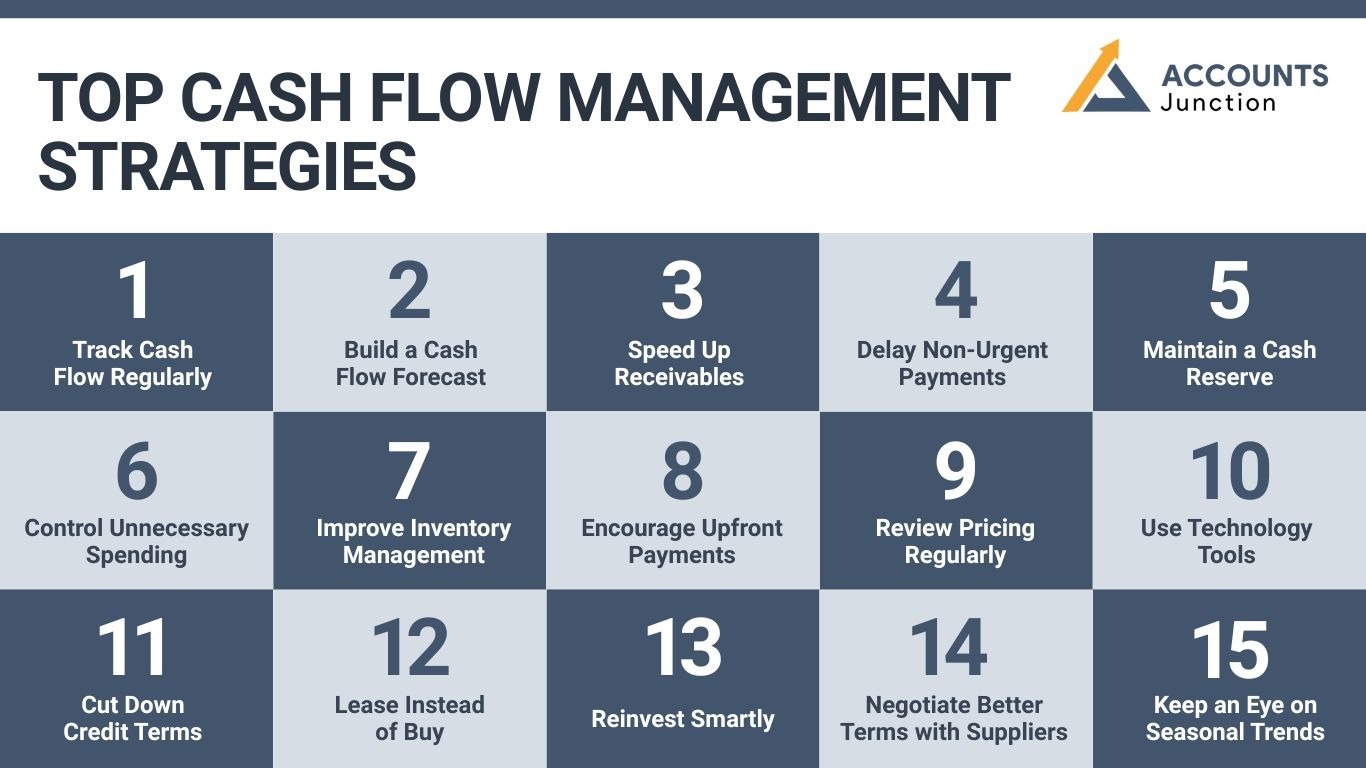
How to Manage Cash Flow? Know These Top Strategies
Money keeps moving fast throughout the business. But, the way it flows can decide the fate of the business. Sometimes, it may come like a stream, and sometimes you end up with dry days. Managing such unpredictable cash flow is challenging. In this blog, you will learn how to manage cash flow with simple yet powerful strategies.
Cash flow is not just about having money in the account. It is about the timing of when cash comes in and when it goes out. A company may show profit on paper but still face trouble if the cash doesn’t flow right. So, how can one keep this balance steady? Let’s explore everything about cash flow.
What Does Cash Flow Really Mean?
Cash flow means the way in which money moves in and out of your business. When excess money comes in than that goes out, you have a positive cash flow. When the opposite happens, there may be a shortage of cash.
It may look simple, but cash flow carries the real pulse of any business. Every payment, bill, sale, or purchase adds to the rhythm. Without the right control, even good profits might not save a company from running dry.
Why Cash Flow Management Matters
Without strong control, small cracks in your financial system can grow large. You may delay supplier payments, miss tax deadlines, or struggle to pay staff. But when you follow smart cash flow management strategies, you gain space to breathe, plan, and grow.
Good management may not always mean more income, but it helps make better use of what already exists. It allows a business to forecast, adjust, and prepare for slow seasons before they cause panic.
Understanding the Types of Cash Flow
There are three main types every business owner should know:
- Operating Cash Flow: The money that comes from normal business work. Sales, services, and day-to-day operations form this part.
- Investing Cash Flow: Money used or gained from assets, property, or other investments.
- Financing Cash Flow: The flow of cash between the business and investors, lenders, or shareholders.
When all three flow in harmony, your finances may stay balanced and strong.
Top Cash Flow Management Strategies
Learning how to manage cash flow takes more than one habit. It’s a set of ongoing actions that help track, adjust, and plan ahead. Here are some of the most effective Cash Flow Management strategies used by smart businesses.
1. Track Cash Flow Regularly
- It all begins with awareness. You can’t manage what you can’t see. Keep a record of your cash movement daily or weekly. Even a simple spreadsheet may help in tracking income and expenses.
- Try reviewing reports often. When you notice changes in your patterns, you may act before problems grow.
2. Build a Cash Flow Forecast
- A forecast can show how much money might come in and go out over the next few months. It may not be perfect, but it gives you direction.
- With this, you may predict tight spots, plan for upcoming bills, and save in advance. It’s like seeing the weather ahead before leaving for a long journey.
3. Speed Up Receivables
- Money owed to you should not sleep in someone else’s account. Offer small discounts for early payments or set clear terms for due dates.
- Sending friendly reminders can also work better than waiting in silence. The faster the cash comes in, the smoother your operations can run.
4. Delay Non-Urgent Payments
- Not all bills need instant payment. If you can, stretch supplier payments slightly (without harming relations). It gives your cash more time to work within your system.
5. Maintain a Cash Reserve
- A cash reserve acts like a safety cushion. It may protect your business from sudden shocks like equipment failure or market slowdown.
- Having three to six months’ worth of expenses saved up can turn panic into patience when tough times strike.
6. Control Unnecessary Spending
- Every business carries hidden leaks. Subscriptions, unused software, or extra inventory may quietly drain cash. Review these often.
- Small cuts made in the right places can strengthen your flow without hurting performance.
7. Improve Inventory Management
- Too much stock locks up cash. Too little stock may lose sales. Balance is key.
- By tracking sales patterns, you can plan what to buy and when to restock. Smart inventory control may save both money and space.
8. Encourage Upfront Payments
- For service-based businesses, partial or full upfront payments may work well. It ensures cash arrives before the work begins.
- This approach reduces risk and keeps your cash steady, especially when projects take time to finish.
9. Review Pricing Regularly
- Sometimes, cash problems are not due to spending but pricing. If your prices have not changed for years while costs rise, your margins shrink.
- Review pricing at least once a year. A small adjustment can bring big improvement to your cash flow.
10. Use Technology Tools
- Modern software can help track invoices, automate billing, and even predict trends. Cloud accounting tools may save hours of manual work and reduce mistakes.
- When used right, they can turn cash management from guesswork into a guided process.
11. Cut Down Credit Terms
- Offering credit to clients can attract business, but long terms may choke your flow. Try shorter payment cycles where possible.
- When you reduce credit days from 60 to 30, you can almost double the cash speed.
12. Lease Instead of Buy
- Buying equipment may sound like an asset, but it ties up large cash chunks. Leasing can spread costs over time.
- It keeps money available for other business needs and helps manage liquidity better.
13. Reinvest Smartly
- Not every profit should go back immediately. Some may need to stay as working capital.
- When cash is thin, growth should wait. It’s wiser to build stability first and expansion later.
14. Negotiate Better Terms with Suppliers
- Good relations with suppliers can bring flexibility. They may offer discounts or extend credit periods if trust runs deep.
- A friendly talk may save more than a formal deal sometimes.
15. Keep an Eye on Seasonal Trends
- Many businesses see ups and downs across the year. Knowing your peak and slow months may help plan cash flow.
- You can save more during high seasons and use it during low ones. Planning ahead can make the rough months easier.
Common Cash Flow Mistakes to Avoid
- Ignoring reports and trends.
- Mixing business and personal expenses.
- Failing to follow up on unpaid invoices.
- Overspending during good months.
- Taking loans without repayment planning.
Awareness can prevent most of these. The earlier you notice, the quicker you can fix them.
Tools That Can Help with cash flow:
Some tools may simplify cash flow tracking:
- Accounting software like QuickBooks or Xero
- Expense management apps
- Online invoicing platforms
- Spreadsheet templates
The right tool can make managing cash less stressful and more predictable.
Sometimes, hiring a bookkeeper or accountant can help manage flow better. They can notice issues you may miss. Professional advice may also guide you toward long-term stability and tax efficiency.
Managing money is not only about figures. It’s also about mindset. A wise business owner stays curious, watches trends, and reacts early. Patience mixed with awareness can turn chaos into control.
Learning how to manage cash flow is not a one-time act. It’s an ongoing practice to keep cash flowing. With the right cash flow management strategies, a business can survive emergency situations. Money may come and go, but control over its flow can decide who stands strong when others fall. Accounts Junction can help you with cash flow management services. If you want your business to stand out from others, contact us now
FAQs
1. What does cash flow mean in simple words?
- It means how money moves in and out of a business.
2. Why is cash flow management important?
- It helps keep a business steady and prevents sudden cash shortages.
3. How often should I track cash flow?
- Weekly tracking may work best for small businesses.
4. Can profit and cash flow be different?
- Yes, profit shows earnings, but cash flow shows real money movement.
5. What is a cash flow forecast?
- It’s a plan showing expected money inflows and outflows for future months.
6. How do I improve my cash flow fast?
- Collect receivables early and delay non-urgent payments if possible.
7. Should I use accounting software for cash flow?
- Yes, tools can help track, automate, and analyze cash easily.
8. Is cash reserve really needed?
- It can act as safety money during slow or tough times.
9. What happens if cash flow turns negative?
- You may struggle to pay bills or suppliers on time.
10. Can cash flow issues cause business failure?
- Yes, poor cash flow may close even profitable firms.
11. How can small businesses manage cash better?
- They can plan, track weekly, and avoid overbuying stock.
12. Should I lease or buy equipment?
- Leasing may help keep more cash free for other needs.
13. Why is timing so important in cash flow?
- Because payments and receipts rarely happen together.
14. Can pricing affect cash flow?
- Yes, low prices may reduce cash even if sales are high.
15. How long should a business keep cash reserves?
- At least 3 to 6 months of basic expenses is ideal.
16. Is it wise to borrow for cash flow problems?
- Only if repayment plans are clear and funds are used well.
17. What is the best way to forecast cash flow?
- Use past data, sales patterns, and expense trends.
18. Can automation improve cash management?
- Yes, it saves time and reduces manual errors.
19. How can seasonal businesses handle cash flow?
- They can save more during busy months for slow periods.
20. What mindset helps manage cash better?
- Stay alert, plan ahead, and act before problems grow.

